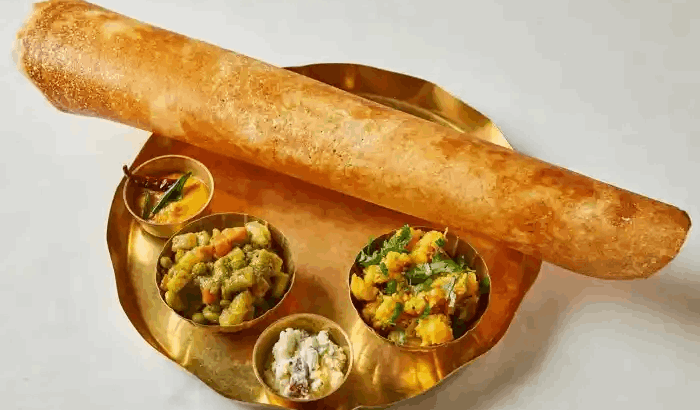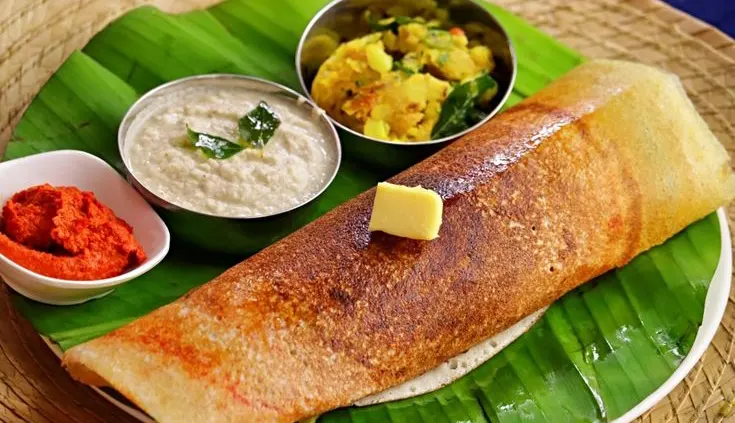Dosa, a cornerstone of South Indian cuisine, epitomizes the elegance of simplicity in cooking. This iconic dish a thin, crispy crepe made from fermented rice and urad dal batter—has captured the imaginations and palates of food enthusiasts around the world. From its humble origins in ancient South India to its status as a global favorite, it is a testament to the rich culinary heritage of the region. This article delves deeply into every facet of this south Indian food, exploring its history, preparation, variations, accompaniments, and its impact on global cuisine.
The Origins of Dosa
The story of dosa begins centuries ago in South India, a region known for its vibrant culinary traditions. Historical records and ancient texts suggest that dosa has been a part of South Indian cuisine for over 2,000 years. The earliest references can be found in Tamil literature from the 5th century AD, where it was described as a type of fermented crepe.
Cultural Significance
In South Indian culture, that is more than just a meal; it is a symbol of hospitality and tradition. It features prominently in breakfast menus across South India and is often served during festivals, special occasions, and family gatherings. The preparation of dosa is considered an art form, with each family having its own secret recipes and techniques passed down through generations.
The Basics of Dosa
Ingredients
The quintessential dosa batter is made from a blend of rice and urad dal (black gram). Here’s a closer look at the core ingredients:
- Rice: Typically, a combination of regular rice and parboiled rice is used. The parboiled rice helps in achieving the desired texture and crispiness.
- Urad Dal: This split black gram adds a unique flavor and aids in fermentation, resulting in a light and airy texture.
- Fenugreek Seeds: These seeds are often included for their subtle flavor and their role in aiding fermentation.
Additional ingredients such as cumin seeds, curry leaves, and green chilies can be added to the batter to enhance its flavor.

Preparation of Batter
- Soaking: The rice and urad dal are soaked separately in water for several hours or overnight. This soaking process is crucial as it softens the grains, making them easier to grind.
- Grinding: The soaked rice and urad dal are ground together into a smooth batter. The consistency should be slightly thicker than pancake batter but thinner than cake batter.
- Fermentation: The batter is left to ferment at room temperature for 8-12 hours. During fermentation, natural yeasts convert the sugars into alcohol and carbon dioxide, giving the dosa its characteristic tangy flavor and airy texture.
Cooking Process
Cooking process and involves a few essential steps:
- Heating the Griddle: A flat griddle or tawa is preheated to medium-high heat. It should be hot enough to cook the dosa quickly but not so hot that it burns.
- Pouring the Batter: A ladleful of batter is poured onto the center of the griddle. Using the back of the ladle, the batter is spread in a thin, circular motion to form a large, thin crepe.
- Cooking: The dosa is cooked until the edges turn golden brown and crispy. A small amount of oil or ghee can be drizzled around the edges to enhance crispiness.
- Serving: The dosa is carefully lifted with a spatula and served hot, often folded or rolled, accompanied by various chutneys and sambar.
Types of Dosa
Dosa comes in many variations, each with its unique flavors and textures. Here’s a look at some popular types:
Plain Dosa
The plain dosa is the most basic form, featuring a crispy, golden exterior with a soft interior. It serves as the foundation for many other varieties and is often enjoyed with a variety of chutneys and sambar.
Masala Dosa
Masala dosa is a favorite variation, filled with a spiced potato mixture. The filling, known as “aloo masala,” typically includes boiled potatoes, onions, mustard seeds, turmeric, and curry leaves. This food is usually served with a side of coconut chutney and sambar.

Rawa Dosa
Made from semolina (rawa) instead of rice, rawa dosa has a distinct texture and slightly different flavor profile. The batter for rawa dosa is thinner, and the dosa tends to be crispier with a more delicate texture.
Paper Dosa
True to its name, paper dosa is incredibly thin and crispy, resembling a sheet of paper. This food is often larger than the standard food and is known for its delicate, crunchy texture.
Neer Dosa
Originating from Karnataka, neer dosa is made from a watery rice batter, resulting in a soft and translucent . It is typically served with coconut-based curries or stews.
Other Regional Variations
Each region in South India has its own unique take on dosa, incorporating local ingredients and flavors. For example, in Andhra Pradesh, this food item may be spiced with red chilies and garlic, while in Tamil Nadu, it might be served with a variety of chutneys and sambar.
Traditional Accompaniments
A dosa meal is incomplete without its traditional accompaniments. Here’s a look at some of the most popular side dishes:
Chutneys
Chutneys are essential to complement the flavors of dosa. Some common varieties include:
- Coconut Chutney: Made from grated coconut, green chilies, and tempered with mustard seeds, curry leaves, and urad dal. This chutney is creamy and slightly spicy.
- Tomato Chutney: Prepared with tomatoes, onions, and spices, this chutney adds a tangy and spicy element to the meal.
- Coriander Chutney: A refreshing chutney made from fresh coriander leaves, green chilies, and spices. It offers a vibrant, herbaceous flavor.
Sambar
Sambar is a lentil-based vegetable stew flavored with tamarind and a special sambar powder blend. It often includes a mix of vegetables such as carrots, potatoes, and drumsticks. Sambar adds a tangy, spicy contrast to the dosa and is a staple in South Indian meals.
Other Side Dishes
- Potato Curry: Often used as a filling for masala dosa, this spiced potato dish can also be served as a side. It typically includes ingredients such as onions, turmeric, and curry leaves.
- Vegetable Stew: A mild, coconut-based curry made with mixed vegetables, this stew pairs well with dosa for a balanced meal.
The Nutritional Aspect
Health Benefits
This is generally a healthy option, especially when made with minimal oil. The fermentation process enhances the batter’s nutritional value by increasing the bioavailability of nutrients. Key benefits include:
- High in Protein: The urad dal provides a significant amount of plant-based protein.
- Rich in Carbohydrates: Rice provides a good source of energy through complex carbohydrates.
- Digestive Benefits: Fermentation aids in digestion and promotes gut health by introducing beneficial bacteria.
Dietary Considerations
Dosa is naturally gluten-free, making it suitable for individuals with celiac disease or gluten intolerance. It can be adapted to various dietary preferences:
- Vegan: Dosa is typically vegan, but if you are concerned about dairy in some chutneys or sambar, ensure these are also plant-based.
- Low-Carb: For a lower-carb option, you can use alternative flours or adjust the batter ratio.

Dosa Around the World
Popularity in India
In India, dosa is a staple breakfast item and a common feature on restaurant menus. Regional variations reflect local ingredients and culinary traditions. For example, Kerala might be served with a spicy vegetable stew, while in Andhra Pradesh, it may be accompanied by a tangy tamarind chutney.
International Adaptations
As South Indian cuisine has gained global recognition, dosa has found its way into international restaurants and fusion dishes. In countries with a significant Indian diaspora, it is often featured in Indian eateries, sometimes with creative twists like dosa wraps or pizzas.
The Art of Making the Perfect
Common Mistakes and How to Avoid Them
Creating the perfect and involves attention to detail. Common issues include:
- Batter Consistency: If the batter is too thick, the food item will be heavy and less crispy. If too thin, it may be too delicate to handle. Aim for a consistency that is slightly thicker than pancake batter.
- Griddle Temperature: An improperly heated griddle can result in a dosa that is either undercooked or burnt. Ensure the griddle is preheated to the right temperature before pouring the batter.
- Uneven Spreading: Spread the batter evenly to avoid thick spots. Using the back of the ladle in a circular motion helps achieve a uniform thickness.

Expert Tips
- Preheat the Griddle: Ensure the griddle is hot before pouring the batter. A hot griddle helps the dosa cook evenly and become crispier.
- Use a Thin Layer of Batter: For a crisp dosa, spread a thin layer of batter. The thinness contributes to the desired texture.
- Add Oil Around the Edges: Drizzling a little oil around the edges of the dosa helps achieve a golden, crispy finish.
Cultural Significance
Dosa in Festivals and Celebrations
Dosa is a beloved dish in South Indian festivals and celebrations, often featured in festive feasts and special meals. During occasions like Pongal, Onam, and Diwali, dosa is enjoyed for its versatility and deliciousness. It is typically served with a variety of chutneys, sambar, and sometimes special fillings or toppings, making it a festive favorite. Its preparation and sharing highlight communal spirit and cultural heritage, adding to the joy of celebrations.
